Canada is home to many magnificent natural wonders. Some such features tower high in the sky, while others plunge into the depths of the Earth. This article will describe 4 of the deepest canyons in Canada, and discuss their formation, geology, animal residents, and activities visitors can enjoy there. Here are 4 of the deepest canyons in Canada.
Background
Canyon Formation
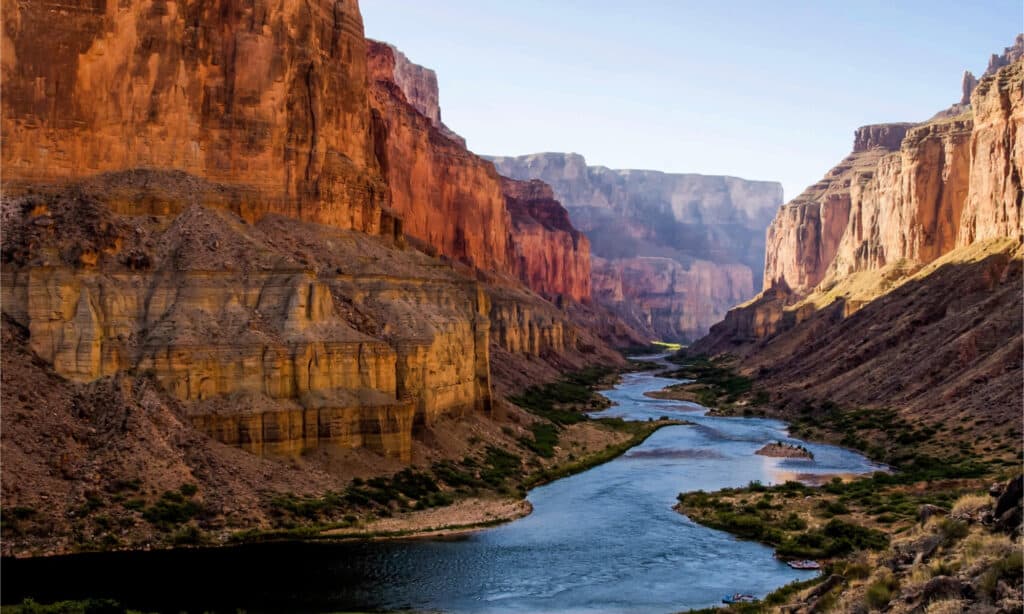
The Grand Canyon was formed by fluvial erosion facilitated by the Colorado River.
©Beth Ruggiero-York/Shutterstock.com
Canyons are geological wonders that come in various shapes and sizes, and they are the result of a multitude of natural forces and geological processes. One of the most common ways canyons form is through the erosional power of flowing water. Over millions of years, rivers and streams cut through layers of rock, carving out deep and narrow channels. This process, known as fluvial erosion, can be accentuated by the force of gravity, as water continuously descends, and it often leads to the formation of V-shaped canyons, such as the iconic Grand Canyon in the United States.
Another prominent force in canyon formation is tectonic activity. When tectonic plates collide or pull apart, they can create fault lines and fissures in the Earth’s crust. Over time, these fractures can widen, and erosion by wind and water can further shape them into canyons. The East African Rift Valley, for example, is a massive tectonic rift that stretches over 6,000 kilometers and has formed numerous canyons and valleys.
Wind is also a sculptor of canyons, albeit on a longer timescale. Wind erosion, or aeolian erosion, gradually wears away at rock formations, particularly in arid and desert regions. The relentless abrasive action of windblown sand and dust can create slot canyons with smooth, curved walls. Antelope Canyon in Arizona, USA, is a famous example of a slot canyon resulting from wind erosion.
In summary, canyons result from a dynamic interplay of natural forces and geological processes, including water erosion, tectonic activity, and wind erosion. These geological wonders provide a window into the Earth’s complex history and the transformative power of time and the elements. The 4 deep canyons in Canada we will investigate exemplify some of these geological processes.
Canyons, Chasms, and Gorges
“Canyons,” “chasms,” and “gorges” are terms that are often used interchangeably to describe deep, steep-sided, and narrow landforms, but there are subtle differences in their usage.
A canyon is a deep and narrow valley with steep sides, typically formed by a river or other erosional forces. Canyons can vary significantly in size and scale, from relatively small canyons to massive ones like the Grand Canyon. The term “canyon” is common in North America, and it often implies a scenic or recreational attraction. Canyons are frequently associated with the erosion of sedimentary rock layers.
A chasm is a deep and steep-sided fissure, cleft, or gap in the Earth’s surface. Chasms can result from various geological processes, including tectonic movements, faulting, or the collapse of underground chambers. “Chasm” generally conveys a sense of depth and separation. However, it may not necessarily relate to running water or a specific erosional process.
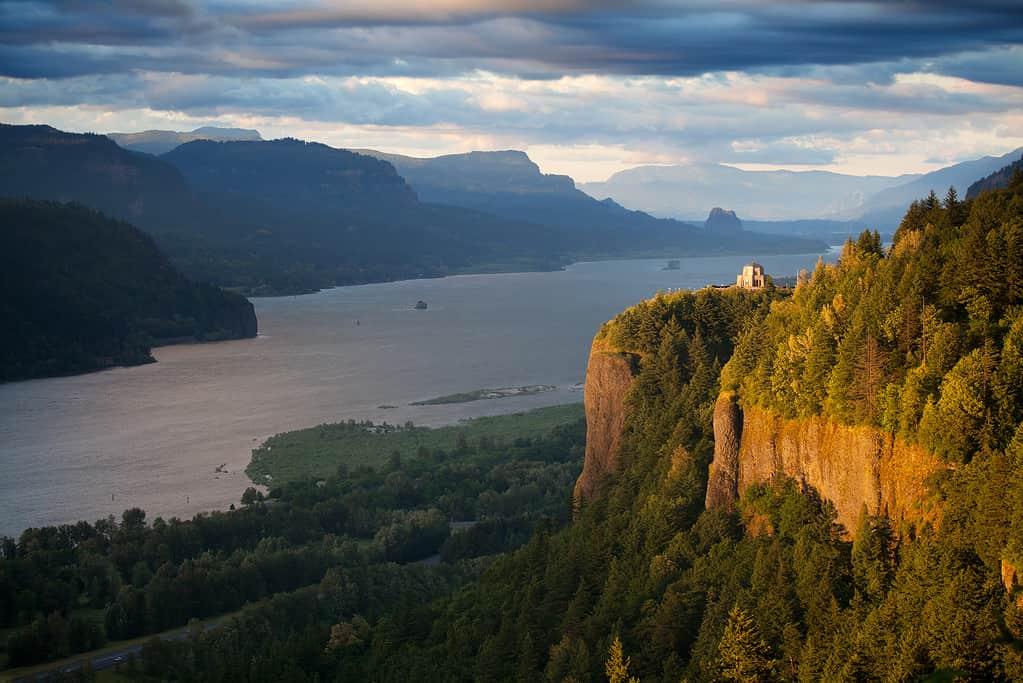
The Columbia River Gorge is a place of great biodiversity that includes a temperate rainforest ecosystem.
©alptraum/iStock via Getty Images
A gorge is similar to a canyon, with steep sides and a narrow valley, and often with a river passage. The term is common in Europe and some other regions. “Gorge” can also refer to a deep ravine or gorge-like feature formed by the erosional activity of water.
In essence, while there are distinctions in terminology and regional preferences, the fundamental characteristics of these landforms involve deep, steep-sided, and often elongated depressions in the Earth’s surface. The primary difference lies in the processes that create them and regional naming conventions. The choice of term often depends on the specific geological history, local culture, and geographical location of the landform in question.
With this information in mind, read on to discover 4 of the deepest canyons in Canada!
#4 Maligne Canyon (50m)
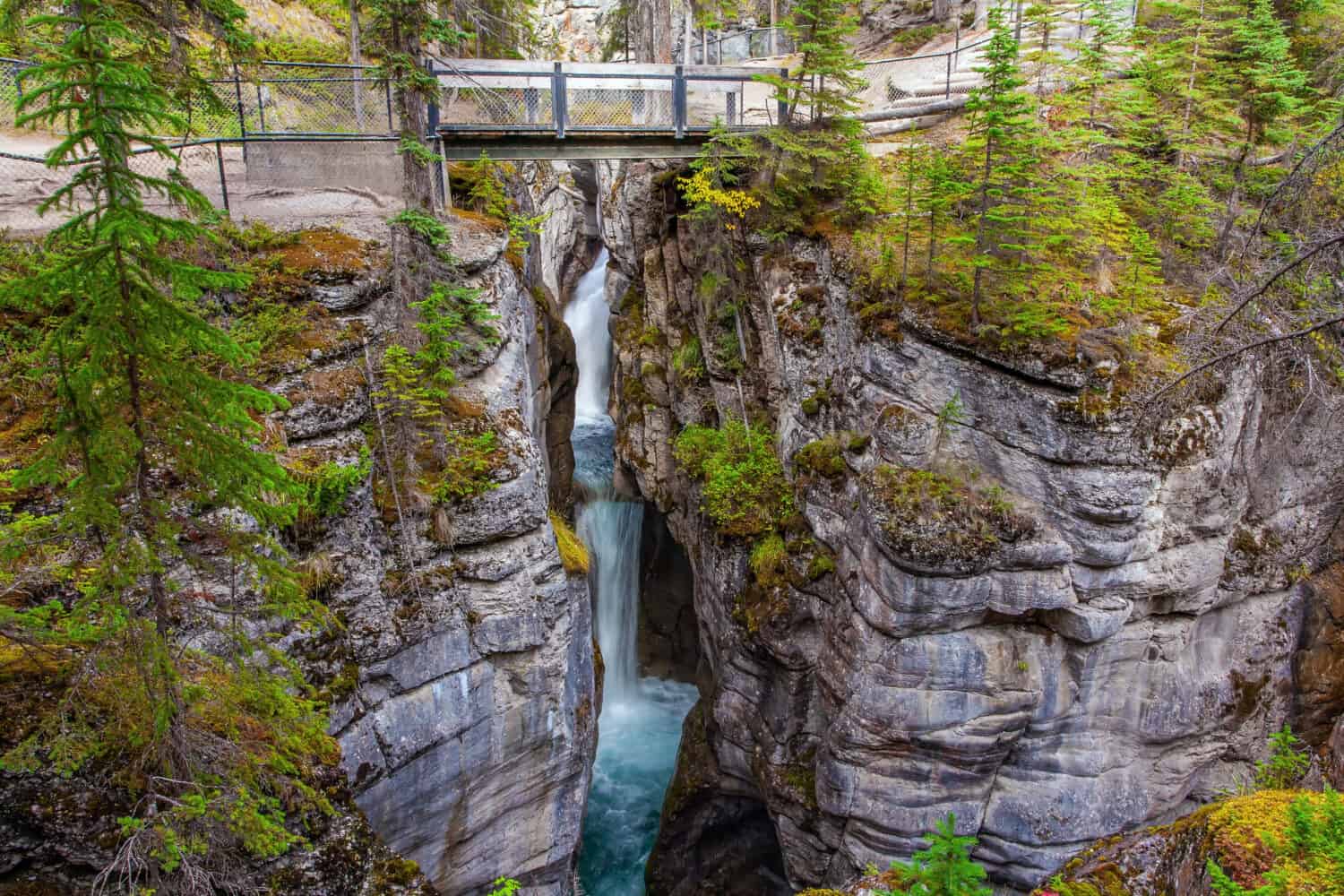
There are many ways you can visit Maligne Canyon and immerse yourself in its beauty. There are many trails and a picturesque bridge for tourists to enjoy.
©kavram/Shutterstock.com
Maligne Canyon reaches depths of up to 50 meters (165 feet) and provides a striking backdrop for visitors. It is located in Jasper National Park in Alberta, Canada, and is one of the most stunning natural features in the Canadian Rockies. It is notable for its rugged beauty and unique geology. Maligne Canyon is the deepest canyon in the national park and is a popular destination for both hikers and sightseers.
The canyon is approximately 11 kilometers (7 miles) from the town of Jasper and is easily accessible. Its geography consists of a deep limestone gorge, with the Maligne River flowing through it. The limestone rock formations have been carved out over millions of years through a combination of dissolution, erosion, and the chemical weathering of the soluble rock. The result is a winding canyon with dramatic sheer cliffs and deep, narrow passages.
In addition to its geological intrigue, Maligne Canyon is also home to a diverse array of wildlife. Visitors might encounter creatures such as black bears, elk, mule deer, and a variety of bird species. The lush vegetation in and around the canyon offers essential habitat for these animals.
Visiting
Visitors to Maligne Canyon can enjoy a range of activities. These include hiking along well-maintained trails that offer spectacular viewpoints of the canyon and waterfalls. In the winter, the canyon takes on a different kind of beauty, as it becomes a popular spot for ice-walking tours. These tours allow visitors to explore the frozen, otherworldly landscape of the canyon during the colder months. Maligne Canyon is also a fantastic location for photography, capturing the natural wonder of the Canadian Rockies. Overall, Maligne Canyon is a must-visit destination for those seeking both natural beauty and geological intrigue in the heart of Jasper National Park.
#3 Ouimet Canyon (100m)
The Ouimet Canyon is an impressive horseshoe-shaped gorge that is 100 meters (330 feet) deep. This Canadian landmark is in the municipality of Dorian in the Northwestern Ontario region. It is part of the Ouimet Canyon Provincial Park. This protected area was established in 1972 and is officially classified as a nature reserve.

The Ouimet Canyon is 150 meters wide.
©Gus Garcia/Shutterstock.com
Ouimet Canyon owes its formation to a combination of geological processes that have unfolded over millions of years. This remarkable natural wonder is the product of a combination of glacial, erosional, and volcanic activities during the last Ice Age. The canyon’s striking features are primarily red rhyolite rock, resulting from volcanic eruptions around 1.2 billion years ago. Over time, glacial activity and erosion by wind and water wore away the surrounding rock layers. This gradually exposed the rhyolite and shaped the deep gorge we see today.
The deep chasm and towering cliffs of Ouimet Canyon create a unique microclimate. This supports a variety of plant life, from boreal forest species to arctic-alpine plants that are typically found much farther north. The canyon itself hosts lush vegetation, with ferns, mosses, and unique rock-dwelling flora. The surrounding area provides habitat for wildlife such as black bears, white-tailed deer, red foxes, and a variety of bird species, including hawks and eagles.
Ouimet Canyon’s rocky cliffs also offer nesting sites for peregrine falcons, adding to its ecological significance. As visitors explore the trails and viewpoints of the canyon and its surroundings, they may have the opportunity to spot these animals and appreciate the unique geological and natural features of this spectacular location. The geological history, diverse plant life, and wildlife make Ouimet Canyon a valuable destination for those interested in both Earth’s ancient processes and the biodiversity of Northwestern Ontario.
Visiting
People looking for an outdoor adventure should certainly pay Ouimet Canyon a visit. There are several boardwalks and well-kept, marked trails. Naturalists interested in rare plants are in for a particularly special treat when visiting the canyon, as well. There are a number of rare alpine flowers and arctic plants in the area that are normally only found at higher latitudes further north. These plants thrive in the unique environment that exists on the canyon floor. Unfortunately, there are no camping facilities in the park but it does have day-use access. There are also picnic shelters and restroom facilities.
#2 The Painted Chasm Canyon (300m)
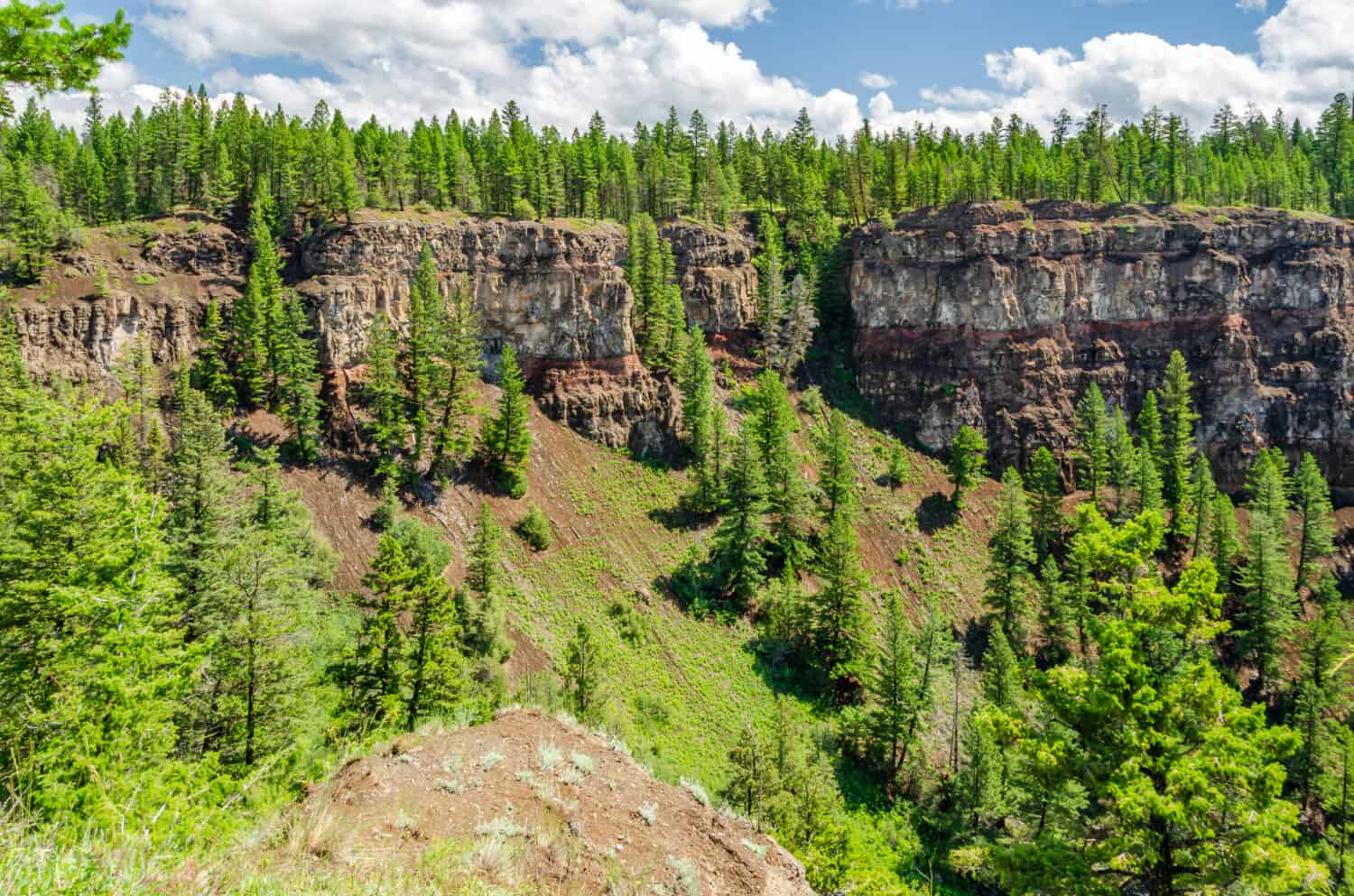
Chasm Park in British Columbia was first established to protect the Painted Chasm in 1940.
©karamysh/Shutterstock.com
One of the deepest canyons in Canada is the Painted Chasm Canyon in British Columbia’s Chasm Provincial Park. This extraordinary canyon has an incredible depth of approximately 300 meters! The park as a whole is 3,067 hectares of diverse ecosystems and landscapes, including the canyon. The canyon earns its name due to its storied walls, which reflect millions of years of erosion. The seemingly “painted” canyon walls portray this long and rich history in a truly awe-inspiring form. The different layers of successive lava flows are visible in the walls and contain beautiful tones of red, brownish-yellow, and purple.
The formation of the canyon was the consequence of extensive geological processes over a very long period. Geologists believe the chasm is the result of melting glacier waters eroding a lava plateau over a 10-million-year span. This lava plateau is called the Chilcotin Group, or the Chilcotin Plateau Basalts. The Chilcotin Group is a large area of basaltic lava that forms a volcanic plateau in south-central British Columbia.
Wildlife living in the park includes many small mammals, bighorn sheep, moose, mule deer, black bears, coyotes, songbirds, and birds of prey. The park supports this great biodiversity in its vast forests of ponderosa pines, low-elevation lakes, and marshes, and various lakes and riverine ecosystems.
Visiting
The Painted Chasm Canyon should be at the top of the travel list for any outdoor enthusiasts. Visitors to Chasm Provincial Park can enjoy well-maintained trails and roadways for hiking and wildlife viewing. An old road leads along the southern edge of the chasm and has a spectacular viewpoint. Also, there are opportunities for cycling, horseback riding, and hunting. Facilities in the park include picnic tables and restrooms.
#1 Grand Canyon of the Stikine (300m)
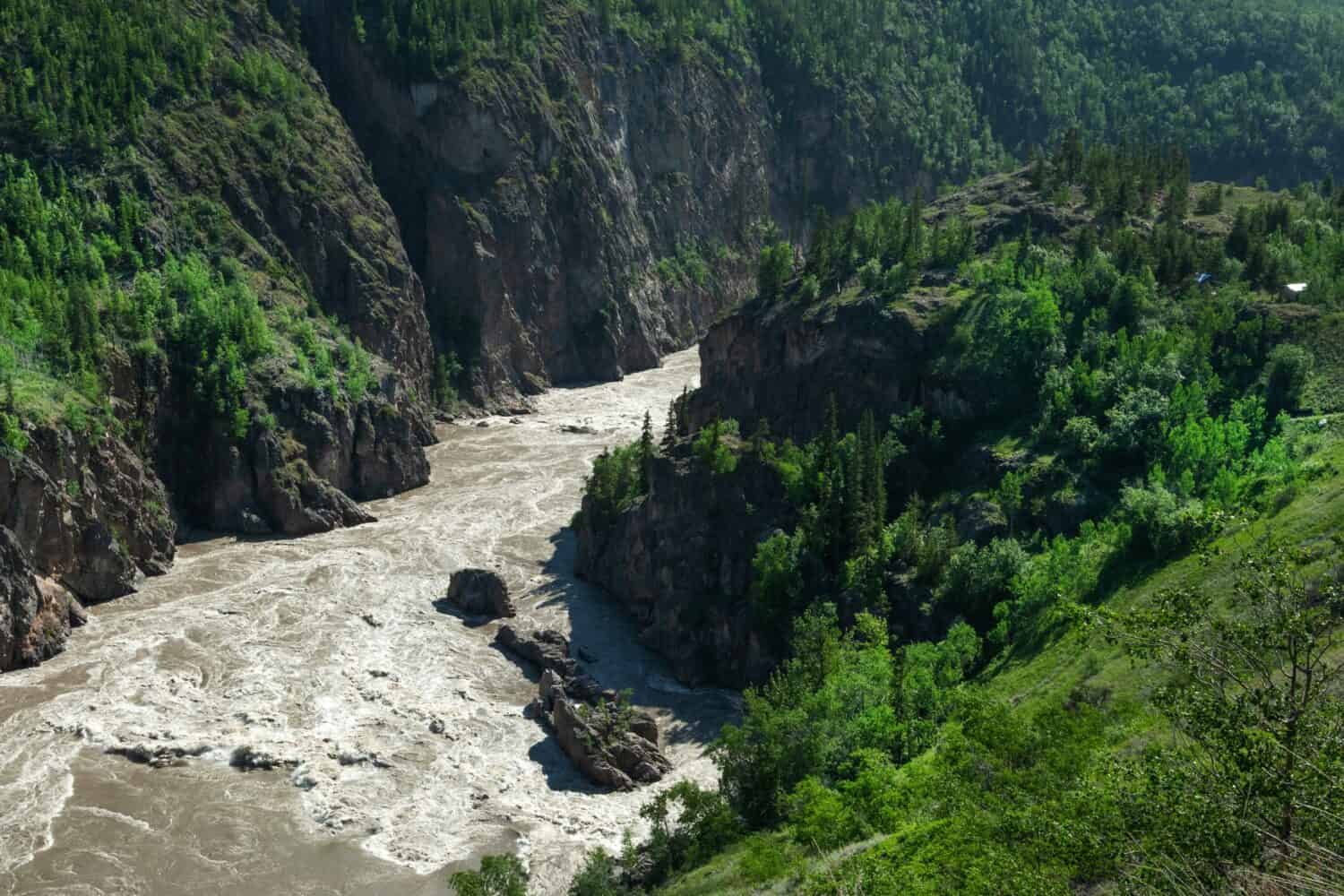
Class 5 rapids like these exist at multiple points within the Grand Canyon of the Stikine.
©Natalia Bratslavsky/Shutterstock.com
Of the 4 largest canyons in Canada, we will explore, the Grand Canyon of the Sitkine is the deepest. It is an astonishing 300 meters deep- just under 1000 feet! The Grand Canyon of the Stikine, in northern British Columbia, Canada, is a remote and awe-inspiring natural wonder that is one of the most rugged and least accessible canyons in North America. This remarkable geological feature is carved by the mighty Stikine River, which has spent millennia eroding the rocks of the region. The Stikine River has cut a deep and narrow chasm through the rugged Coast Mountains, exposing breathtaking layers of rock that offer a glimpse into the Earth’s geological history.
The canyon has steep cliffs, towering peaks, and narrow gorges, creating a dramatic and breathtaking landscape. The geological processes responsible for shaping the Grand Canyon of the Stikine include glacial activity during the last Ice Age, followed by the relentless erosional power of the river. The Stikine River, with its powerful flow, has carved through layers of sedimentary and volcanic rock over millions of years, creating a deep and winding canyon.
The area around the Grand Canyon of the Stikine is home to a variety of wildlife, including eagles, black bears, mountain goats, and other species adapted to the challenging terrain. The pristine wilderness surrounding the canyon is part of the allure for nature enthusiasts and outdoor adventurers.
Visiting
Visitors to this remote and wild region can explore the canyon and its surroundings through activities such as river rafting, wilderness hiking, and camping. This area is a haven for those seeking adventure in a pristine, untouched natural environment. However, due to its remote location and challenging access, a trip to the Grand Canyon of the Stikine requires careful planning and should ideally be done with the assistance of experienced guides or outfitters. It offers a unique opportunity to immerse oneself in a truly unspoiled and majestic corner of the Canadian wilderness.
Deepest Canyon in North America
Hells Canyon (2,452m)
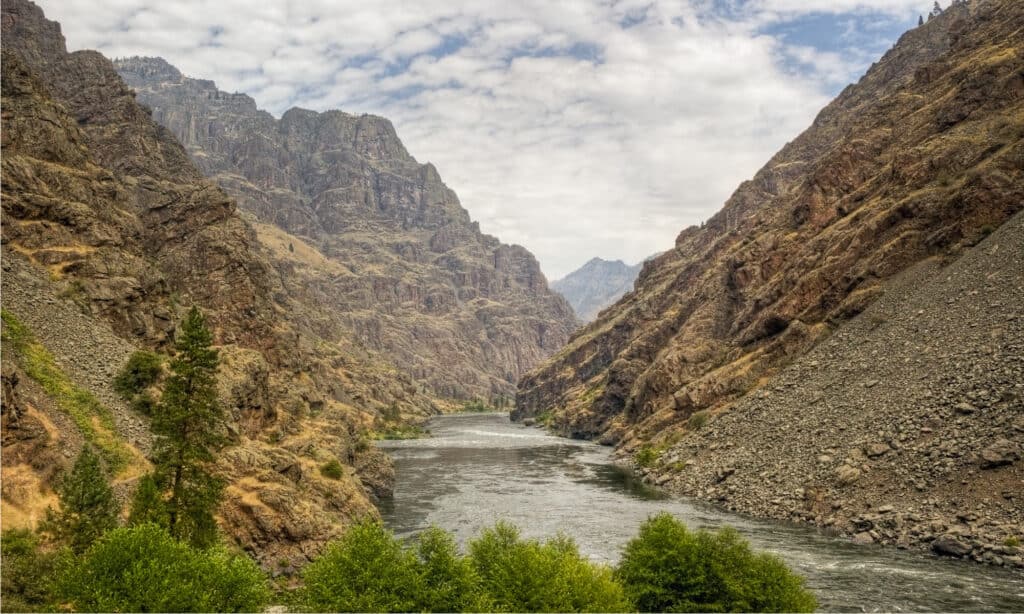
Hells Canyon National Recreation Area is 652,488 acres of incredible landscapes.
©Jeffrey T. Kreulen/Shutterstock.com
In addition to these 4 deep canyons in Canada, there are many even deeper canyons in North America more broadly. According to the United States National Park Service, Hells Canyon is the deepest canyon in North America at 8,043 feet (2,452m), making it even deeper than the Grand Canyon. It is in the western United States along the border of Idaho and Oregon and stretches over 10 miles at its widest point. This impressive geological feature was carved over millions of years by the powerful Snake River, which flows through the canyon’s depths. The region’s unique geology is a mix of granite, basalt, and sedimentary rock layers, indicating a rich history of volcanic activity and geological processes.
Hells Canyon offers a variety of landscapes, from towering cliffs to dense forests, and its geography creates a dramatic experience for visitors. The canyon’s sheer walls and rugged terrain make it a prime location for outdoor enthusiasts, including hikers, rafters, and wildlife enthusiasts. The area is famous for its diverse wildlife, including bighorn sheep, mule deer, black bears, and several bird species. The Snake River, which runs through the canyon, is also teeming with fish like salmon and steelhead, making it a popular spot for anglers.
Visiting
Visitors to Hells Canyon can enjoy a range of activities. Hiking trails traverse the canyon, offering breathtaking views of the surrounding landscape. Rafting and kayaking are popular on the Snake River, providing adventurous opportunities to explore the canyon from its depths. For those seeking a more relaxed experience, there are scenic boat tours and wildlife-watching opportunities. The region’s rich history is also on display, with remnants of Native American culture and early settlers in the area. Hells Canyon is a place where visitors can connect with nature, witness the power of geological forces, and appreciate the diverse wildlife that calls this magnificent canyon home.
Safety
Safety in canyons is paramount to ensure an enjoyable and risk-free experience. Whether you’re a casual observer, hiker, or rock climber, understanding and adhering to safety guidelines is essential.
Viewing Safety
When viewing canyons from designated overlooks or platforms, stay behind guardrails and obey all posted signs and warnings. Canyons often have unstable edges, and slipping or falling can lead to severe injuries or fatalities. Keep a safe distance from cliff edges, especially when taking photos. Be mindful of changing weather conditions, as canyons can be prone to sudden storms and flash floods. Always check the weather forecast and be prepared to seek shelter if necessary.
Hiking Safety
If you plan to hike in a canyon, research the trail beforehand and choose routes that match your skill and fitness level. Wear appropriate footwear with good traction, bring plenty of water, and inform someone of your plans, including your expected return time. Pay attention to trail markers and follow established paths. Be cautious when navigating steep or slippery sections, and avoid hiking alone, if possible. Carry essential safety equipment, such as a first aid kit and a whistle, and know how to use them.
Rock Climbing Safety

Many canyons offer opportunities for rock climbing. Make sure you know how to be safe before you head out.
©DisobeyArt/Shutterstock.com
Canyons often attract rock climbers looking for challenging routes. Prioritize safety by using appropriate safety gear, including helmets, harnesses, and ropes. Check the condition of the rock and anchors, and be cautious of loose or unstable rock. Follow established climbing ethics and adhere to Leave No Trace principles by minimizing environmental impact. When climbing in canyons, understanding rescue procedures and having communication devices is crucial, as help may not be readily available.
Wildlife Viewing Safety
To ensure the well-being of both animals and tourists in Canada, follow ethical guidelines. Maintain a respectful distance, avoid feeding wildlife, and stay quiet to minimize stress for the creatures. Be aware of the environment and pack essentials like binoculars and a camera to capture the beauty of Canada’s diverse wildlife, from majestic bears and moose to elusive birds in their natural habitat. Always prioritize safety, and respect the natural world and its inhabitants.
The photo featured at the top of this post is © Gus Garcia/Shutterstock.com
Thank you for reading! Have some feedback for us? Contact the AZ Animals editorial team.






